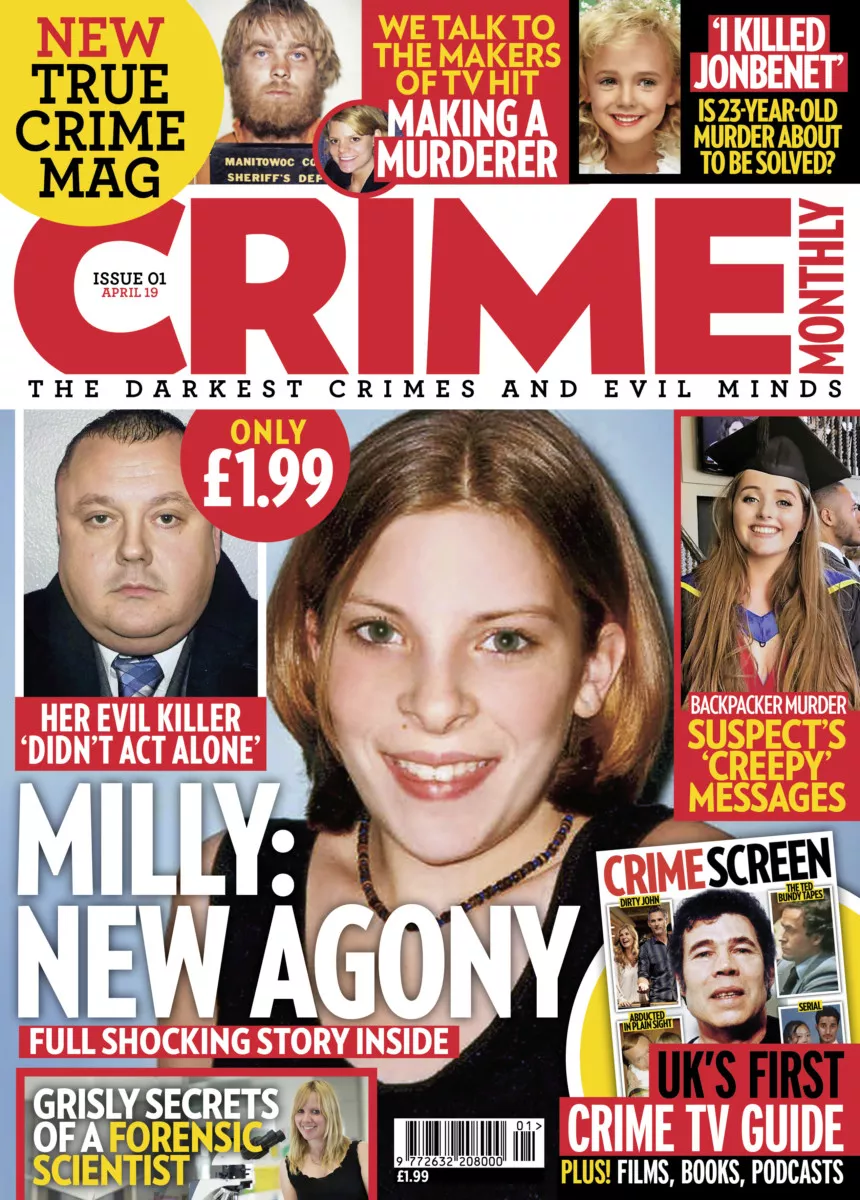‘Crime Monthly’ Magazine Reveals Our Crime Porn Obsession for What It Is

Credit to Author: Hannah Ewens| Date: Fri, 08 Mar 2019 13:51:51 +0000
What do you get when a gossip magazine team makes a true crime magazine? Milly Dowler as a cover girl.
Surrounding Dowler’s image on the front of the Crime Monthy launch issue are other murdered girls and young women: Grace Millane, a young British backpacker; six-year-old JonBenét Ramsey; and Teresa Halbach, the victim in the Steven Avery case. Theirs are not the only faces when crime is made entertainment: Dowler’s killer is also there, staring out coldly at the reader.
When the cover was revealed online earlier this week, responses ranged from dubious to outraged. Some said it was a cheap play from publisher Bauer Media for the true crime market, others thought it was supposed to be satire. The reason being: while there’s nothing wrong with true crime writing, packaging it like a glossy doesn’t exactly give it the gravity or sensitivity it deserves. At first glance, Crime Monthly looks like an issue of Heat magazine – another Bauer title – only, instead of Cheryl Tweedy having a “breakdown” or Jessica Simpson putting on weight, there are stories of other fallen women.
The first issue came out yesterday, and the magazine’s creators – including Editor-in-Chief, Julia Davis, who also oversees Heat – urged people to read it before preemptively judging Crime Monthly on its cover. “We don’t want to just be regurgitating old crimes just for the sake of it,” Davis told the Press Gazette.
Unfortunately, given that three of the main features are about Dowler, JonBenét and the Manson murders – some of the most extensively covered crime stories in the history of time – it’s clear there is a fair bit of lazy regurgitation going on. Each feature claims to add a new angle – for Dowler and JonBenét, that’s essentially “there’s a new TV show out about it” – but then rehashes the same old facts, most of which you could find on the crime’s Wikipedia page.
One particularly distasteful feature is the “Anatomy of a Crime Scene” – a two-page photo of a crime scene, with a paragraph introduction briefly explaining the crime and annotations of blood splatter, the spot where the victim died and so on.
Later, a mind-boggling lack of self-awareness is demonstrated in one feature about James Bulger. The short piece focuses on the debate around whether the filmmakers of Oscar-nominated Detainment – a short film about the case – were right to make it, when they didn’t contact the families of the victims. The piece parrots the debate without offering any opinions or alternatives, since to do so would be to engage with the magazine’s own ethics. Why and how are we packaging these real life stories? What do victims’ families think of their loved ones being used to sell a magazine?
The final page of the magazine has a “Famous Last Words” slot, in which Aileen Wuornos’ psychologically complex case of abuse, sex work and murder is reduced to a few brief paragraphs and a pull quote. Like the rest of the content, it’s oddly reductive and there to titillate.
From a purely editorial standpoint, the magazine could have had some merit. To their credit, there are features that focus on less publicised crimes, but the way they’re handled – as a brief overview – still feels jarring, not helped by the glossy-style layout. Elsewhere, in articles not focusing directly on a specific crime, there’s some decent (albeit brief) material: an interview with a forensic scientist about her work, a feature on the women behind Making a Murderer – and the fact they’ve chosen to highlight the work of women is a nice counterpoint to all the dead girls. Still, it’s not quite enough.
Ultimately, it is our own fault that Crime Monthly exists. It’s here because of our insatiable desire for true crime media: documentaries, books, podcasts and dedicated 24-hour crime channels. We have already made murderers into celebrities, Crime Monthly is just taking the next step. Print media is struggling, and Bauer is a brand that has been adverse to investing fully in digital media. It clearly realises that, with direct access to celebrities via their social media, audiences have less of an interest in weekly women’s mags vocalising everything they’ve already seen – but might be more willing to pay £1.99 for 74 pages of true crime content.
Conversations are already being had about our current true crime obsession. Has it gone too far? When does it become exploitative? Can’t we just… not? Crime Monthly not only coaxes out our fascination, but makes it grossly accessible. The magazine’s tagline is: The Darkest Crimes And Evil Minds. At this point we must ask: why are we so hungry for that?
This article originally appeared on VICE UK.